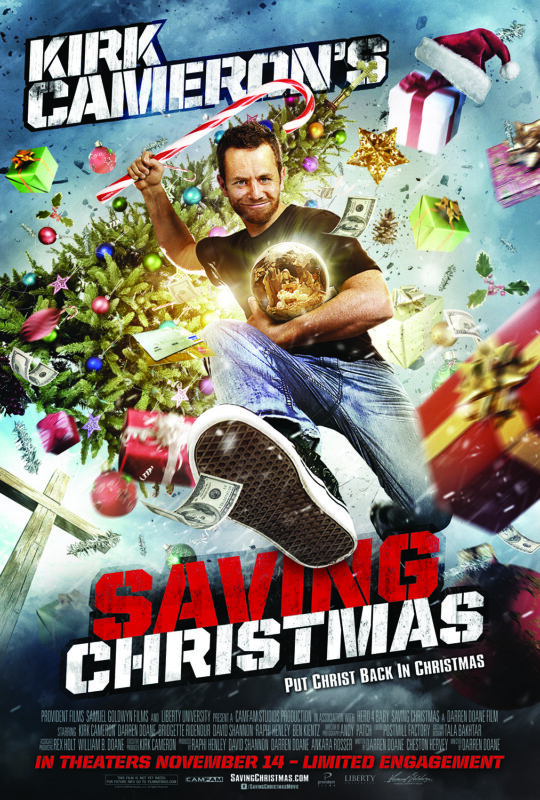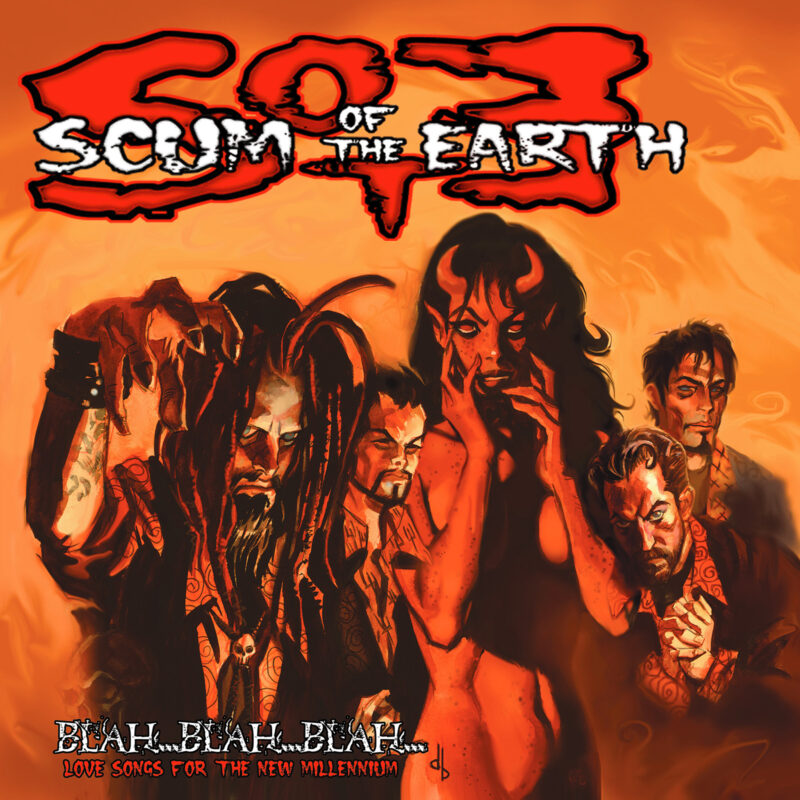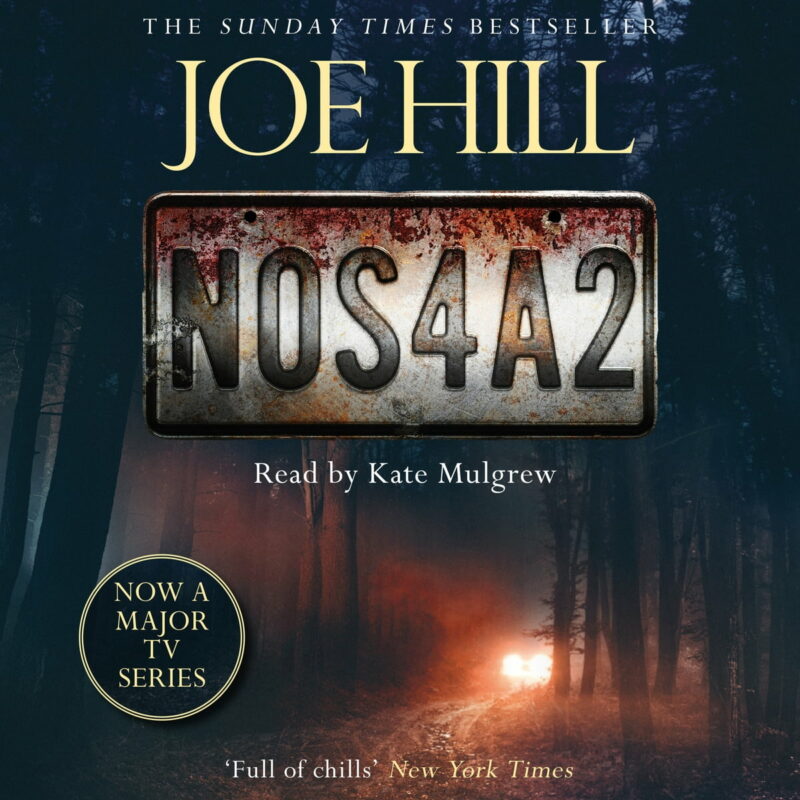
I saw this film for Christmas, the most wonderful time of the year.
One advantage of me being Australian (aside from the whole walking upside down thing, which gets old fast) is that I have an outsider’s view on American entertainment. For example, I don’t know who Kirk Cameron is. A sitcom actor, or something. When Saving Christmas came out and was hammered by critics, many reviews took the line of “haw haw! It’s Mike Seaver from Growing Pains!” I didn’t care about that stuff. I judged the film on its own demerits.
It’s terrible. Silver linings, though: we’re still celebrating Christmas in 2022, which means Kirk’s crusade to save the holiday was a success. I wonder how he did it?
Don’t be fooled by the action-packed cover: Saving Christmas is a vlog of Kirk Cameron sitting in front of a camera, gesturing with his simian hands, his ghastly chimp-like visage twisting with rancid condescension as he explains the meaning of Christmas to all of us dumb idiots. I have never felt so patronized by a stupid person. He has the energy of an uncle explaining that airplanes fly by flapping their wings.
He knows how to save a buck, I’ll give him that. The movie has two sets: “some dude’s house”, and “some dude’s car”. Occasionally he spices things up with “B-footage” that looks like it came from a stock footage site. This film cost literally dozens of dollars to make, and I hope it earned back every penny.
Is this even a movie? In 2017 it barely passed muster. In 2022 it more resembles a high-effort Youtube video by someone called “The Libtard Crusher” whose avatar is Trump throwing Fauci out of a helicopter. All it lacks is a crudely animated furry character who looks smug when he makes a point…well, it has Kirk Cameron, now that I think of it.
So what dubious message does Craptain Kirk have for us?
It’s not “Christmas is overcommercialized!” Kirk is all for commercialization. “Don’t buy into the complaint about materialism during Christmas. Sure, don’t max out your credit cards or use presents to buy friends, but remember, this is a celebration of the eternal God taking on a MATERIAL body. So, it’s right that our holiday is marked with material things.”
He argues – unconvincingly – that “secular” traditions (Christmas trees, nutcrackers, Santa Claus) are Biblically-based. Nutcrackers? They’re soldiers, and Herod had soldiers. Christmas trees? Jesus was crucified on a cross made of wood, which comes from trees. Baubles? They represent the fruit in the Garden of Eden. And so forth.
It’s a simple formula. Is $THING part of Christmas? Just Ctrl-F search for $THING in the Bible, and there you go. Anything you like can be a Biblically-approved Christmas tradition. “Like a computer wrote it” is a common criticism lobbed at movies that are formulaic or uninspired. Saving Christmas goes further: it’s the world’s first movie that could have been written by a one-line Bash script.
Winter? Well, God created the winter solstice. When he’s in a pinch, Cameron falls back to the “God made it” argument, which kind of makes the rest of the film unnecessary, because then everything is part of Christmas.
And this distresses me, because my family had a disgusting proctopaedophiliac Christmas tradition called “oobleklaart”. It’s a heinous sex act, banned in 31 countries and counting, involving a monkey, an unripe rambutan, a power drill, and…ugh…just thinking about it makes me shudder. Those poor gerbils…
Anyway, if Kirk is correct, oobleklaart is authentically part of Christmas, because the 27 separate items and ingredients necessary to perform it (we’ll ignore the plutonium-239, which is man-made) all come from God. Is this true? Is oobleklaart Christmas? Say it isn’t so, Kirk.
In general, I’m not on board with attempts to make Christianity hip and happening.
Firstly, none of these people would recognize “hip” if theirs was smashed by a sledgehammer. At the end there’s a rapped version of “Angels We Have Heard On High”, which is a risky move for a group of actors who have never heard a rap CD that didn’t have “CLEAN VERSION” on it. When they dance, they flail like electrified corpses.
Christianity should transcend cool. The Bible has a certain dignity to it. It’s not a trite or silly book. Trying to tie it up with a bunch of toys doesn’t even reach the level of sacrilige. It speaks to a cultish obsession with dopamine that’s as secular as it gets. “Don’t ask questions! Just consume product and then get excited for next product!” Christmas may survive commercialism. It may not survive Kirk Cameron.

In 2004, Rob Zombie fired his guitarist. This guitarist – who had performed on the multi-platinum Hellbilly Deluxe and had clearly done a lot of the songwriting – immediately formed a new band, Scum of the Earth, along with White Zombie’s Ivan DePrume, and Powerman 5000’s Mike Tempesta.
This kind of “double band” thing is traditionally a way to settle scores and prove who mattered and who didn’t. Would Rob Zombie fail without Mike Riggs? Would Scum of the Earth become the new hotness? Would Bush be re-elected and, if so, would he succeed in “making the pie higher”? These were the questions we asked in 2004.
Spoiler: Rob won. He is still selling out arenas and making movies and touring with balding fifty year old sex criminals. Mike Riggs now works as a tattoo artist. Few remember Scum of the Earth’s inauspicious debut album today, and even fewer will tomorrow.
It deserved better. At least, it didn’t deserve to be totally forgotten. The album is fun. A little cheap sounding, but do you care if liquor comes in a cardboard box if your goal is to get wrecked on it?
Blah…Blah…Blah…Love Songs for the New Millennium demonstrates one thing: the Hellbilly Deluxe sound was indeed Riggs’. You hear it everywhere: the slamming, grooving riffing style, the electronic rhythms, the stop-start dynamics. This is unmistakably the brain (and picking hand) that created “Dragula”. Sometimes the songwriting is uncannily close, such as on album highlight “Murder Song”. When Blah…Blah…Blah… is good (and it is on about half its songs) it sounds far more like Rob Zombie than Rob Zombie’s post-Riggs music, which could be described as “70s nostalgia with about two heavy songs to make the fans happy”.
So what went wrong? Why did the album flop?
Well, larger-than-life shock rock needs a larger-than-life frontman, and Riggs had little charisma or showmanship. Back in the Ozzfest/Family Values days he seemed like a gruesome sideman to Rob, with a hollow acrylic Fernandez guitar that he could fill with blood or rotten meat. But once he had to front his own band he came across as a shy, reticient guy without much to say.
Riggs anti-promoted Blah…Blah…Blah… with truly incredible interviews, such as this one. What makes this project different from any of your previous musical endeavors? “I don’t know…Different people.” What does Rob Zombie think of the band? “I don’t know.” What will you be doing for Halloween this year? “Playing a show somewhere, can’t remember.” He promises to make a second album, and says that it will be “Hopefully, better than the first.”. In a genre where megalomania is virtually a job requirement, this man was hell-bent on discouraging you from listening to his music.
This indifference carries over to the album’s lyrics. Rob Zombie isn’t the greatest lyricist, but he can always be relied on for Burroughs-style lines that send your mind down interesting places. Riggs’ writing is seriously uninspired. Once he’s murdered some sluts and worshipped the devil a few times, he seems to run out of material.
And he cannot sing at all.
He doesn’t have a good voice. That’s the big problem here, particularly as the music is so vocally-driven. He seems to have known it, too: I recall him asking his label to allow him to work with a different singer. They refused, because of some stupid reason that I’ve forgotten and presumably only makes sense to record labels. He should have walked right then. It’s so obvious that this band needed a better singer.
He yelps, slurs, and barks, in a thin and high-sounding voice that’s about three notes deep. The various production tricks (like the way his vox track is slimed up with heavy chorusing) just draw attention to his vocal deficiencies like a blinking engine light.
It gets worse. “Little Spider” and “Give Up Your Ghost” feature acoustic guitars and clean singing. I am proud so say that I have never listened to either song all the way through and I never will.
The production is all over the place. Indie albums often have a fractured, piecemeal quality – they get recorded in various places, when dribbles of money become available – and that’s very apparent here. No two songs are mixed or recorded the same way. The kicks on “Murder Song” are are a healthy +6dB louder than the ones on “Get Your Dead On”. The guitars on “Nothing Girl” have a scooped out Tim Skold/KMFDM character (to the point where they might as well be synths), while “I Am the Scum” sounds like nu metal. The snare drum on “Pornstar Champion” is a digital sample, but the rest of the drums are live.
It’s a bit of a mess. And since Riggs lacks Rob’s major label Rolodex, he can’t paper over his weak spots with guests like Ozzy Osbourne and Tommy Lee and Iggy Pop. A random groupie sings on “Bloodsuckinfreakshow”, along with Riggs’ own son. Apparently the kid agreed to “perform” in exchange for two thousand dollars, terms which Riggs agreed to, on the condition that that the label had to pay him first. They apparently never did, so for all I know, Riggs’ son is still waiting for his two thousand dollars!
So the two big draws of Rob Zombie (the massive production and massive voice) aren’t here. What’s left is Riggs’ musicianship and guitar playing, which carries a lot of these songs. But by the time you get to nothing songs like “Nothing Girl”, you’re just listening to filler. This is a thirty-six minute album that actually runs for about fifteen. It could and perhaps should have been an EP.
I was a big Rob Zombie/Powerman 5000 fan at the time I discovered this – an early version of this site was called The Australian Nightmare, after Rob’s Howard Stern theme song. But this triggered a tyranny of small differences thing in me. There’s nothing worse than a thing you love done just a little bit wrong, and Blah…Blah…Blah… is a lot wrong.
Now that my obsession with Rob Zombie has faded, I can actually appreciate it. It’s forgotten and obscure, but it has its moments, and being dead is no hardship at all for a zombie.

The title shows Joe Hill’s best side: his playful wit. The book is funny at times: and often because it means to be. It also shows his fatal flaw, which we’ll get to soon.
The book’s about larger-than-death pop-villain Charles Talent Manx III. He’s a vampiric creature who kidnaps children in a Rolls Royce Wraith with a NOS4A2 vanity plate. He’s Dracula, John Wayne Gacy, and Michael Jackson at once. Why couldn’t I have been murdered and left on the side of the road by this guy in 1973, instead of that Dennis Rader jerk?
Set against him is Vic McQueen, who also has paranormal gifts: She cross an imaginary bridge and find missing things at the other side. This is described as an “inscape”, a mental shortcut that some creative types exploit (damaging their health in the process). Maybe not the most original or subtle metaphor for drugs, but that’s where NOS4A2 works. The story is bold, brash, and full of color – even if it’s usually color from a spraygun and not a paintbrush.
But the pun in the title doesn’t quite work – nitrous oxide systems first appeared in automobiles in the 1950s, and Manx’s car is from 1938 – and this points to the problem with NOS4A2: it never gains the weight and heft of reality. It’s obviously a construct. The book is too clever, too full of references. It badly wants entry to the gated world of classic horror novels, to the point where it tries to pick the lock.
The plot reads like Stephen King’s ten most famous novels compacted in a hydraulic press. Vampires. Haunted car. Haunted house. Girl with supernatural gift. Ancient evil that feeds of children. Drug metaphor. Creepy undead kids. I was about to say “at least there’s no cornfield”. Then I remembered that there is a cornfield.
Sometimes the namedropping is blatant, such as when we find that Manx’s wintery retreat is in Colorado, or when Bing says “My life for you!” to Manx.
If I’m just lazily listing things, that’s how the book feels, too. While it would be unfair to call it a grinding, soulless list of in-jokes and references like Clown in a Cornfield (the world’s first “young adult” book written exclusively for forty year olds consoomers) the book is deadened by its use of horror cliches. Events in NOS4A2 don’t happen to people, in places. They happen to stock figures in generic settings, most of which are lifted from 1980s books from the author’s own father.
Is this what horror’s supposed to be? I don’t think so.
Horror is meant to be a scalpel to the amygdala. It wakes instinctive fears you might not have been aware you had. It thrives off the unexpected, off dissonance. It can’t become ever become “cosy” or a franchise without losing its soul, but we’re at the point where there’s 20 designated “spoopy ideas” that books variously shuffle around and recombine in various orders, hoping to strike gold again. It’s a real shame. Horror needs to climb out of its own ass.
Another problem is that NOS4A2 is paced very fast. The narrative’s sediment is never allowed to settle. Hill is trying to do too much here – right out of the gate we’re bombarded with various unrelated bizarre, dramatic, or supernatural things (Manx, Vic McQueen’s magic bike, Bing), along with rapid shifts in time and place that leave book’s cohesion in tatters. And there’s no displacement when paranormal events start occurring, because they occur almost from the first page!
Stephen King’s books are usually paced far slower, which gives them a certain stateliness. The nightmarish gross-out scenes are freighted down by a lot of everyday life – nothing happens for an extremely long time in Pet Semetary or The Green Mile, because he’s building up the characters and their world. NOS4A2 thinks it can race through all that in fifth gear, but it really can’t.
In the final pages, the action builds up to an exhilerating climax that goes for broke, takes out a small loan of a million dollars, then spends that, too. Hill’s a gifted natural writer, with an eye for quick, effective characterization. Early on we meet Bing Partridge, a chemical plant worker who might be developmentally disabled. Bing exclusively reads old pre-war magazines and paperbacks, and when he writes a letter, his prose is hilariously stilted and old-timey. This is a subtle but good touch. So is the way Vic goes from idolizing David Hasselhoff to hating him. Lots of writers forget the huge gap between twelve year olds and fourteen year olds, but Hill hasn’t.
But sometimes his characters ring hollow. “McQueen” is an irritating, phoney-sounding name, meant to anchor the book in car culture, and she’s such a congenital screwup that we don’t believe she’d grow up to write a best-selling puzzle book full of brain-teasers. And Vic gets a romantic interest: a big, mellow easygoing from the left side of the bell curve. Yet he’s characterized with a fannish interest in Marvel comics (to the point where he’ll argue what color the Hulk’s skin should be). Have you ever met a comic book fan? They’re not mellow and easygoing. They’re angry, vicious, and highly strung. Lou Carmody caring about comic books is about as believable as Barney Gumble running The Android’s Dungeon.
Most of the book is entertaining and well written. I just don’t enjoy (or respect) a lot of what it’s trying to do. NOS4A2 is loudness-war Stephen King, with the bad amped up far more than the good.



